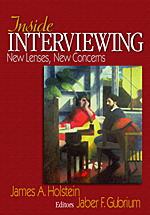Inside Interviewing
New Lenses, New Concerns
- James Holstein - Marquette University, USA
- Jaber F. Gubrium - University of Missouri, USA
Marjorie L. DeVault and Liza McCoy
Marjorie L. DeVault and Liza McCoy
Charles L. Briggs
Charles L. Briggs
Charles L. Briggs
"The editors' introduction is excellent, providing a brief history of interiewing as a research technique and highlighting many of the issues that concern today's research interviewers...Inside Interviewing would be valuable for doctoral-level research methods classes, as well as for practicing researchers. It is an excellent starting point for examining specific issues, such as reflexivity."
A very useful text for those using interviews in research projects.
A very concise and precise insight into the important aspects of interviewing as a data collection method. This text explores interviews from a number of different perspectives and highlights the awareness in the reader that interviews cannot be approached or taken at face value. The text reminds the reader of the other essential elements associated with interviewing such as different ages, cultures, etc. I will be recommending this text to any of my students who are interested in using interviews as a data collection method.
Good additional reading for our RM modules
Interesting and useful. Useful for exploring various ways of interviewing e.g. e mail, telephone and computer assisted interviewing.
Provides an indepth evaluation of this research method. Useful to level 6 and postgraduate students.
this book is highly recommended to post graduate students- I found it easy to read and understand and practical which is exactly what students/researchers need.
This text explores the varied roles that interview participants play. It also covers the theoretical dimensions of subjectivity, and how this awareness can affect the interview process. Another important issue covered in this text is the interpretational challenges researchers face in the analysis of data collected.


